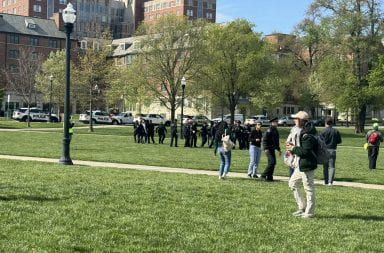Natural rubber is imported into the United States from foreign sources, primarily in southeast Asia. But Ohio State officials are looking to Russian dandelions to give rubber production domestic roots.
The Ohio Agriculture Research and Development Center (OARDC) and collaborators are evaluating Russian dandelions as a method to produce natural rubber domestically.
“The rubber on the bottom of your shoes, the rubber on your bicycle tires, the rubber on your car tires, in airplane tires that you land on and take off on, you know, everywhere you encounter natural rubber, maybe with the exception of very few medical applications,” said Matt Kleinhenz, associate professor in the College of Food, Agriculture and Environmental Sciences and extension specialist at Wooster. “If it’s natural rubber, I can guarantee you it came from southeast Asia.”
OSU researchers and scientists are working with other universities and organizations to commercialize natural rubber in the U.S. The project, “Program of Excellence in Natural Rubber Alternatives” (PENRA), uses dandelions that are native to Uzbekistan and Kazakhstan, Kleinhenz said.
OSU and the PENRA partners received a $3 million grant for the project through the Third Frontier Wright Projects Program, a program that encourages collaborations between Ohio universities and companies, according to the OARDC website.
OARDC partnered with Bridgestone Americas Center for Research and Technology (BACRT), Cooper Tire, Ohio BioProducts Innovation Center, Veyance Technologies, the U.S. Department of Agriculture, the University of Akron and Oregon State University, in PENRA, according to the OARDC website.
Natural rubber is the largest raw material used in Bridgestone’s tires, said Bob Handlos, BACRT’s vice president of research.
“Having a (natural rubber) source in the U.S. or North America will significantly reduce the costs,” Handlos said. “Typically the rubber now comes by ship and takes a long time to get here. It is very costly to ship that way, but by having a source within the United States, it could significantly reduce shipping costs. We hope in the end the rubber will cost less to produce than the material that we are using now.”
Although the project’s plant, commonly known as a Russian dandelion, looks like a typical dandelion, a close-enough look can indicate that it is a different species, Kleinhenz said.
The process used to extract the rubber, which is in the root of the Russian dandelions, is through milling, at OARDC’s Wooster campus, Kleinhenz said.
“(The extraction) involves mills and hot water, and time-honored and obviously modified processes that are proven to be effective,” he said.
After the milling process, “what you end up with is essentially a large cloth of semi-congealed natural rubber, or latex,” Kleinhenz said.
Further processing results in what looks like a white latex, he said.
“We’re very optimistic that an acre of Russian dandelions will produce 500 lbs, if not 2,000 lbs of natural rubber,” Kleinhenz said.
The rubber is then tested for its possible commercialization, Kleinhenz said.
“The businesses who rely on natural rubber know a lot about it,” Kleinhenz said. “So were happy to give our rubber to them for testing.”
Kleinhenz said if PENRA is successful, a new industry will emerge, including new factories that will produce natural rubber.
“(The industry) will include farmers, equipment suppliers, everything that’s required to process and produce the crop and process the rubber,” Kleinhenz said. “You will see businesses that use natural rubber benefiting from the natural supply.”
Handlos said BACRT will receive rubber from OARDC this summer and will test the Russian dandelion rubber against the rubber from southeast Asia.
“We’re monitoring (testing), were assisting with suggestions, and obviously were assisting with the dollars in the program,” Handlos said.
BACRT is a sponsor for PENRA, Handlos said. The dollar amount that the organization is providing is confidential, he said.
Beth Bianco, a fourth-year in agricultural and extension education and former Agricultural Education Society president, said if the natural rubber from the Russian dandelions does take off, it could help the U.S. in many ways, including the economy and agriculture.
The PENRA project is beneficial to sustainability because of its production of natural rubber instead of synthetic rubber, Bianco said.
“We’re moving into a phase of natural and sustainable materials and we’re moving away from synthetics.” Bianco said.
Kleinhenz said OARDC’s collection of Russian dandelions is unique in its genetic resources.
“In terms of its size and in terms of its uses in the cornerstone of the industry,” Kleinhenz said, “what we have is not replicated in any other spots in the world.”


